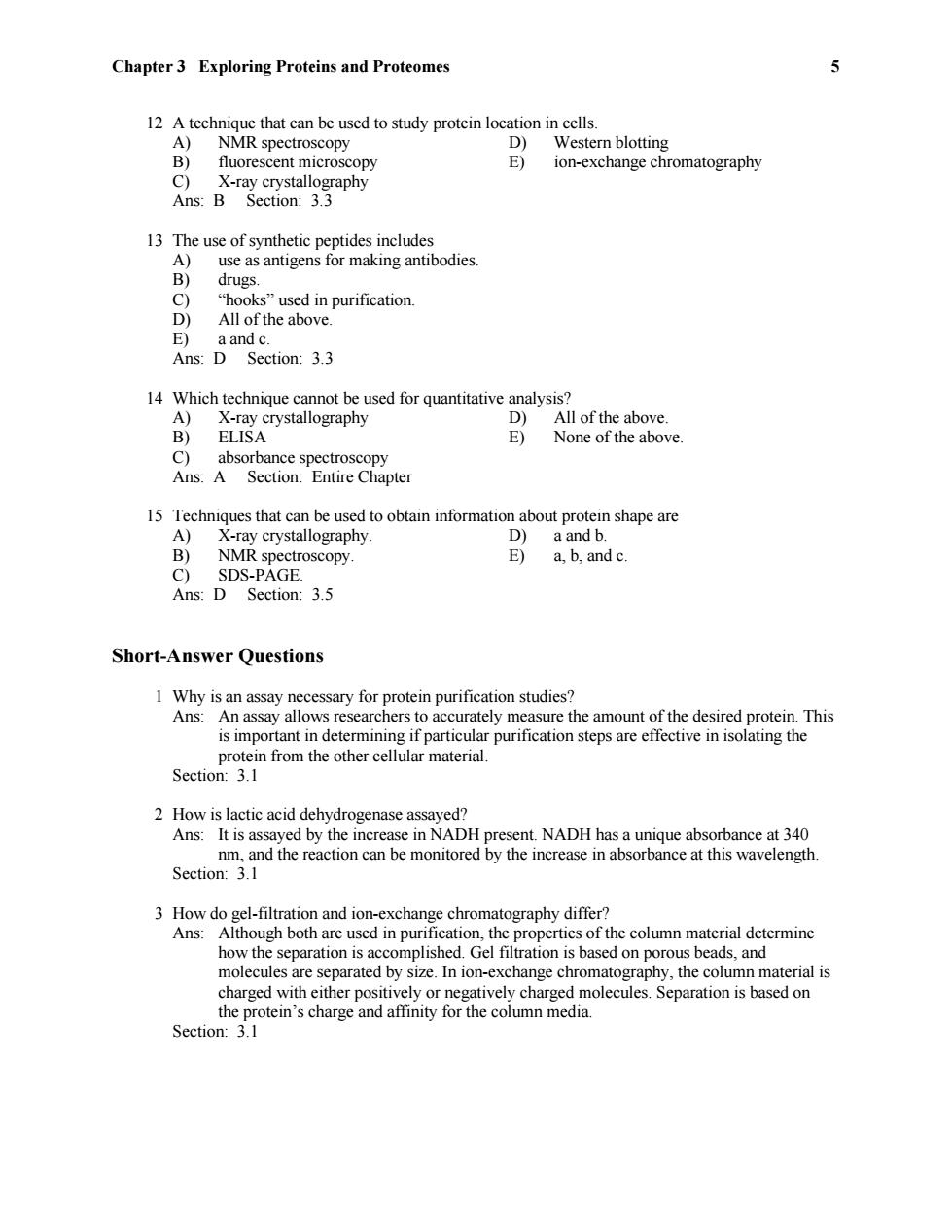正在加载图片...

Chapter 3 Exploring Proteins and Proteomes 12 A technique that can be used to study protein location in cells. A) NMR spectroscopy D)Western blotting B) fluorescent microscopy E) ion-exchange chromatography C) X-ray crystallography Ans:B Section:3.3 13 The use of synthetic peptides includes A) use as antigens for making antibodies. B) drugs. C) "hooks"used in purification. D) All of the above. E)a and c. Ans:D Section:3.3 14 Which technique cannot be used for quantitative analysis? A)X-ray crystallography D)All of the above. B)ELISA E) None of the above. C) absorbance spectroscopy Ans:A Section:Entire Chapter 15 Techniques that can be used to obtain information about protein shape are A) X-ray crystallography. D)a and b. B) NMR spectroscopy. E) a.b,and c C)SDS-PAGE. Ans:D Section:3.5 Short-Answer Questions 1 Why is an assay necessary for protein purification studies? Ans:An assay allows researchers to accurately measure the amount of the desired protein.This is important in determining if particular purification steps are effective in isolating the protein from the other cellular material. Section:3.1 2 How is lactic acid dehydrogenase assayed? Ans:It is assayed by the increase in NADH present.NADH has a unique absorbance at 340 nm,and the reaction can be monitored by the increase in absorbance at this wavelength. Section:3.1 3 How do gel-filtration and ion-exchange chromatography differ? Ans:Although both are used in purification,the properties of the column material determine how the separation is accomplished.Gel filtration is based on porous beads,and molecules are separated by size.In ion-exchange chromatography,the column material is charged with either positively or negatively charged molecules.Separation is based on the protein's charge and affinity for the column media. Section:3.1Chapter 3 Exploring Proteins and Proteomes 5 12 A technique that can be used to study protein location in cells. A) NMR spectroscopy D) Western blotting B) fluorescent microscopy E) ion-exchange chromatography C) X-ray crystallography Ans: B Section: 3.3 13 The use of synthetic peptides includes A) use as antigens for making antibodies. B) drugs. C) “hooks” used in purification. D) All of the above. E) a and c. Ans: D Section: 3.3 14 Which technique cannot be used for quantitative analysis? A) X-ray crystallography D) All of the above. B) ELISA E) None of the above. C) absorbance spectroscopy Ans: A Section: Entire Chapter 15 Techniques that can be used to obtain information about protein shape are A) X-ray crystallography. D) a and b. B) NMR spectroscopy. E) a, b, and c. C) SDS-PAGE. Ans: D Section: 3.5 Short-Answer Questions 1 Why is an assay necessary for protein purification studies? Ans: An assay allows researchers to accurately measure the amount of the desired protein. This is important in determining if particular purification steps are effective in isolating the protein from the other cellular material. Section: 3.1 2 How is lactic acid dehydrogenase assayed? Ans: It is assayed by the increase in NADH present. NADH has a unique absorbance at 340 nm, and the reaction can be monitored by the increase in absorbance at this wavelength. Section: 3.1 3 How do gel-filtration and ion-exchange chromatography differ? Ans: Although both are used in purification, the properties of the column material determine how the separation is accomplished. Gel filtration is based on porous beads, and molecules are separated by size. In ion-exchange chromatography, the column material is charged with either positively or negatively charged molecules. Separation is based on the protein’s charge and affinity for the column media. Section: 3.1